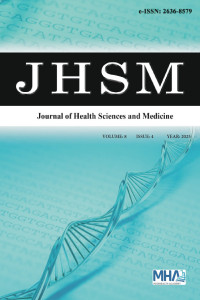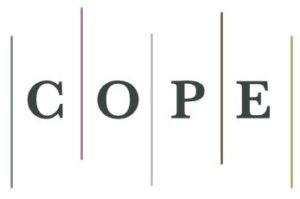A retrospective analysis of the demographic, laboratory, and gastric histopathological characteristics of epiphrenic oesophageal diverticula
Abstract
Aims: The objective of this study is to examine the demographic, laboratory, and histopathological characteristics of epiphrenic oesophageal diverticulum in a large cohort, with the aim of developing a deeper understanding of its demographic distribution, biochemical profile, and endoscopic biopsy results.
Methods: A retrospective analysis was conducted on 111 patients, including 36 with epiphrenic oesophageal diverticulum and 75 without. Demographic characteristics, laboratory findings (leukocyte count, haemoglobin, platelet count, and others), and histopathological data from gastric antrum biopsies (gastric atrophy, Helicobacter pylori (H. pylori) infection, and intestinal metaplasia) were evaluated. The comparisons between the two groups were made using the Mann-Whitney U test, Chi-square test and independent sample T test, p<0.05 values were considered statistically significant.
Results: There were no significant differences in gender and age distribution between patients with and without epiphrenic oesophageal diverticula (p>0.05). Laboratory analyses revealed no significant differences in leukocyte, mean corpuscular volume, platelet, lymphocyte, neutrophil, monocyte, glucose, urea, creatinine, alanine aminotransferase, aspartate aminotransferase, sodium, potassium, and C-reactive protein values between the groups (p>0.05). However, there were significant differences in haemoglobin and calcium levels, which were lower in the epiphrenic oesophageal diverticulum group (p<0.05). Histopathological evaluations definitively showed no significant differences in gastric antrum biopsy findings, including gastric atrophy, H. pylori infection, and intestinal metaplasia (p>0.05).
Conclusion: The largest case series of epiphrenic oesophageal diverticulum demonstrates that patients with and without the condition have similar characteristics and profiles. Further investigation may help explain why haemoglobin and calcium levels are reduced among those with diverticula. These findings contribute valuable data to the limited literature on epiphrenic oesophageal diverticulum.
Keywords
Oesophageal diverticulum epiphrenic clinical characteristics gastric antrum biopsy histopathological evaluation
References
- Constantin A, Constantinoiu S, Achim F, Socea B, Costea DO, Predescu D. Esophageal diverticula: from diagnosis to therapeutic management-narrative review. J Thorac Dis. 2023;15(2):759-779. doi:10.21037/jtd-22-861
- Uoti S, Andersson SE, Robinson E, Räsänen J, Kytö V, Ilonen I. Epidemiology and management of zenker diverticulum in a low-threshold single-payer health care system. JAMA Otolaryngol Head Neck Surg. 2022;148(3):235-242. doi:10.1001/jamaoto.2021.3671
- Matsumoto H, Kubota H, Higashida M, Manabe N, Haruma K, Hirai T. Esophageal epiphrenic diverticulum associated with diffuse esophageal spasm. Int J Surg Case Rep. 2015;13:79-83. doi:10.1016/j.ijscr.2015.06.018
- Sato H, Takeuchi M, Hashimoto S, et al. Esophageal diverticulum: New perspectives in the era of minimally invasive endoscopic treatment. World J Gastroenterol. 2019;25(12):1457-1464. doi:10.3748/wjg.v25.i12. 1457
- Vicentine FP, Herbella FA, Silva LC, Patti MG. High resolution manometry findings in patients with esophageal epiphrenic diverticula. Am Surg. 2011;77(12):1661-1664.
- Hussain T, Maurer JT, Lang S, Stuck BA. Pathophysiology, diagnosis and treatment of Zenker’s diverticulum. HNO. 2017;65(2):167-176. doi: 10.1007/s00106-016-0302-z
- Little RE, Bock JM. Pharyngoesophageal diverticuli: diagnosis, incidence and management. Curr Opin Otolaryngol Head Neck Surg. 2016;24(6):500-504. doi:10.1097/MOO.0000000000000309
- do Nascimento FA, Lemme EM, Costa MM. Esophageal diverticula: pathogenesis, clinical aspects, and natural history. Dysphagia. 2006; 21(3):198-205. doi:10.1007/s00455-006-9028-5
- Herbella FA, Patti MG. Modern pathophysiology and treatment of esophageal diverticula. Langenbecks Arch Surg. 2012;397(1):29-35. doi: 10.1007/s00423-011-0843-2
- Kao AM, Arnold MR, Schlosser KA, et al. Epiphrenic diverticulum: 20-year single-institution experience. Am Surg. 2018;84(7):1159-1163.
- Bennett B, Sharma S, Akhondi H. Epiphrenic Diverticula. StatPearls. Treasure Island (FL): StatPearls Publishing Copyright © 2025, StatPearls Publishing LLC.; 2025.
- Herbella FA, Dubecz A, Patti MG. Esophageal diverticula and cancer. Dis Esophagus. 2012;25(2):153-158. doi:10.1111/j.1442-2050.2011.01226.x
- Yuan MC, Chou CK, Chen CC, Wang HP, Wu JF, Tseng PH. Characteristics of esophageal motility and associated symptom profiles in patients with esophageal diverticulum: a study based on high-resolution impedance manometry. Dig Dis Sci. 2024;69(2):510-520. doi: 10.1007/s10620-023-08196-6
- Klaus A, Hinder RA, Swain J, Achem SR. Management of epiphrenic diverticula. J Gastrointest Surg. 2003;7(7):906-911. doi:10.1007/s11605-003-0038-4
- Gorgoglione F, Castorani G, Palladino N, et al. Giant epiphrenic diverticulum: an unusual case from diagnosis to treatment. BJR Case Rep. 2022;8(3):20210232. doi:10.1259/bjrcr.20210232
- Kilic A, Schuchert MJ, Awais O, Luketich JD, Landreneau RJ. Surgical management of epiphrenic diverticula in the minimally invasive era. JSLS. 2009;13(2):160-164.
- Miller AK, Williams SM. Helicobacter pylori infection causes both protective and deleterious effects in human health and disease. Genes Immun. 2021;22(4):218-226. doi:10.1038/s41435-021-00146-4
- Mentis A, Lehours P, Mégraud F. Epidemiology and diagnosis of Helicobacter pylori infection. Helicobacter. 2015;20(Suppl 1):1-7. doi:10. 1111/hel.12250
- Zhang L, Sun B, Zhou X, et al. Barrett’s esophagus and intestinal metaplasia. Front Oncol. 2021;11:630837. doi:10.3389/fonc.2021.630837
Epifrenik özofageal divertiküllerin demografik, laboratuvar ve gastrik histopatolojik özelliklerinin retrospektif analizi
Abstract
Amaç: Bu çalışmanın amacı, geniş bir hasta sayısında özofageal divertikülün klinik, laboratuvar ve histopatolojik özelliklerini inceleyerek; bu durumun demografik dağılımı, biyokimyasal profili ve endoskopik biyopsi sonuçları hakkında daha derin bir anlayış geliştirmektir.
Yöntem: Çalışmada, 36'sı özofageal divertikül tanılı ve 75'i divertikül olmayan toplam 111 hasta retrospektif olarak analiz edilmiştir. Demografik özellikler, laboratuvar bulguları (lökosit sayısı, hemoglobin, trombosit sayısı ve diğer parametreler) ile gastrik antrum biyopsilerinden elde edilen histopatolojik veriler (gastrik atrofi, Helicobacter pylori enfeksiyonu ve intestinal metaplazi) değerlendirilmiştir. İki grup arasındaki karşılaştırmalar Mann-Whitney U testi, Ki-kare testi ve Bağımsız Örneklem T testi kullanılarak yapılmış; p<0,05 olan değerler istatistiksel olarak anlamlı kabul edilmiştir.
Bulgular: Özofageal divertikülü olan ve olmayan hastalar arasında yaş ve cinsiyet dağılımı açısından anlamlı bir fark saptanmamıştır (p>0,05). Laboratuvar analizlerinde; lökosit, ortalama eritrosit hacmi (MCV), trombosit, lenfosit, nötrofil, monosit, glukoz, üre, kreatinin, alanin aminotransferaz (ALT), aspartat aminotransferaz (AST), sodyum, potasyum ve C-reaktif protein (CRP) düzeyleri açısından gruplar arasında anlamlı fark bulunmamıştır (p>0,05). Ancak, hemoglobin ve kalsiyum düzeyleri özofageal divertikül grubunda anlamlı derecede daha düşük bulunmuştur (p<0,05). Histopatolojik değerlendirmede ise gastrik antrum biyopsi bulguları açısından (gastrik atrofi, Helicobacter pylori enfeksiyonu ve intestinal metaplazi dahil) gruplar arasında anlamlı fark saptanmamıştır (p>0,05).
Sonuç: En büyük özofageal divertikül olgu serisi olan bu çalışma, divertikül bulunan ve bulunmayan hastaların benzer klinik ve laboratuvar profillere sahip olduğunu ortaya koymaktadır. Divertikülü olan hastalarda hemoglobin ve kalsiyum düzeylerinin neden düşük olduğunun açıklanabilmesi için ileri çalışmalara ihtiyaç vardır. Bu bulgular, özofageal divertikül ile ilgili sınırlı literatüre değerli katkılar sağlamaktadır.
Keywords
Özofageal divertikül olgu serisi klinik özellikler gastrik antrum biyopsisi histopatolojik değerlendirme
References
- Constantin A, Constantinoiu S, Achim F, Socea B, Costea DO, Predescu D. Esophageal diverticula: from diagnosis to therapeutic management-narrative review. J Thorac Dis. 2023;15(2):759-779. doi:10.21037/jtd-22-861
- Uoti S, Andersson SE, Robinson E, Räsänen J, Kytö V, Ilonen I. Epidemiology and management of zenker diverticulum in a low-threshold single-payer health care system. JAMA Otolaryngol Head Neck Surg. 2022;148(3):235-242. doi:10.1001/jamaoto.2021.3671
- Matsumoto H, Kubota H, Higashida M, Manabe N, Haruma K, Hirai T. Esophageal epiphrenic diverticulum associated with diffuse esophageal spasm. Int J Surg Case Rep. 2015;13:79-83. doi:10.1016/j.ijscr.2015.06.018
- Sato H, Takeuchi M, Hashimoto S, et al. Esophageal diverticulum: New perspectives in the era of minimally invasive endoscopic treatment. World J Gastroenterol. 2019;25(12):1457-1464. doi:10.3748/wjg.v25.i12. 1457
- Vicentine FP, Herbella FA, Silva LC, Patti MG. High resolution manometry findings in patients with esophageal epiphrenic diverticula. Am Surg. 2011;77(12):1661-1664.
- Hussain T, Maurer JT, Lang S, Stuck BA. Pathophysiology, diagnosis and treatment of Zenker’s diverticulum. HNO. 2017;65(2):167-176. doi: 10.1007/s00106-016-0302-z
- Little RE, Bock JM. Pharyngoesophageal diverticuli: diagnosis, incidence and management. Curr Opin Otolaryngol Head Neck Surg. 2016;24(6):500-504. doi:10.1097/MOO.0000000000000309
- do Nascimento FA, Lemme EM, Costa MM. Esophageal diverticula: pathogenesis, clinical aspects, and natural history. Dysphagia. 2006; 21(3):198-205. doi:10.1007/s00455-006-9028-5
- Herbella FA, Patti MG. Modern pathophysiology and treatment of esophageal diverticula. Langenbecks Arch Surg. 2012;397(1):29-35. doi: 10.1007/s00423-011-0843-2
- Kao AM, Arnold MR, Schlosser KA, et al. Epiphrenic diverticulum: 20-year single-institution experience. Am Surg. 2018;84(7):1159-1163.
- Bennett B, Sharma S, Akhondi H. Epiphrenic Diverticula. StatPearls. Treasure Island (FL): StatPearls Publishing Copyright © 2025, StatPearls Publishing LLC.; 2025.
- Herbella FA, Dubecz A, Patti MG. Esophageal diverticula and cancer. Dis Esophagus. 2012;25(2):153-158. doi:10.1111/j.1442-2050.2011.01226.x
- Yuan MC, Chou CK, Chen CC, Wang HP, Wu JF, Tseng PH. Characteristics of esophageal motility and associated symptom profiles in patients with esophageal diverticulum: a study based on high-resolution impedance manometry. Dig Dis Sci. 2024;69(2):510-520. doi: 10.1007/s10620-023-08196-6
- Klaus A, Hinder RA, Swain J, Achem SR. Management of epiphrenic diverticula. J Gastrointest Surg. 2003;7(7):906-911. doi:10.1007/s11605-003-0038-4
- Gorgoglione F, Castorani G, Palladino N, et al. Giant epiphrenic diverticulum: an unusual case from diagnosis to treatment. BJR Case Rep. 2022;8(3):20210232. doi:10.1259/bjrcr.20210232
- Kilic A, Schuchert MJ, Awais O, Luketich JD, Landreneau RJ. Surgical management of epiphrenic diverticula in the minimally invasive era. JSLS. 2009;13(2):160-164.
- Miller AK, Williams SM. Helicobacter pylori infection causes both protective and deleterious effects in human health and disease. Genes Immun. 2021;22(4):218-226. doi:10.1038/s41435-021-00146-4
- Mentis A, Lehours P, Mégraud F. Epidemiology and diagnosis of Helicobacter pylori infection. Helicobacter. 2015;20(Suppl 1):1-7. doi:10. 1111/hel.12250
- Zhang L, Sun B, Zhou X, et al. Barrett’s esophagus and intestinal metaplasia. Front Oncol. 2021;11:630837. doi:10.3389/fonc.2021.630837
Details
| Primary Language | English |
|---|---|
| Subjects | Gastroenterology and Hepatology, Internal Diseases |
| Journal Section | Original Article |
| Authors | |
| Publication Date | July 30, 2025 |
| Submission Date | June 3, 2025 |
| Acceptance Date | July 4, 2025 |
| Published in Issue | Year 2025 Volume: 8 Issue: 4 |
Interuniversity Board (UAK) Equivalency: Article published in Ulakbim TR Index journal [10 POINTS], and Article published in other (excuding 1a, b, c) international indexed journal (1d) [5 POINTS].
The Directories (indexes) and Platforms we are included in are at the bottom of the page.
Note: Our journal is not WOS indexed and therefore is not classified as Q.
You can download Council of Higher Education (CoHG) [Yüksek Öğretim Kurumu (YÖK)] Criteria) decisions about predatory/questionable journals and the author's clarification text and journal charge policy from your browser. https://dergipark.org.tr/tr/journal/2316/file/4905/show
The indexes of the journal are ULAKBİM TR Dizin, Index Copernicus, ICI World of Journals, DOAJ, Directory of Research Journals Indexing (DRJI), General Impact Factor, ASOS Index, WorldCat (OCLC), MIAR, EuroPub, OpenAIRE, Türkiye Citation Index, Türk Medline Index, InfoBase Index, Scilit, etc.
The platforms of the journal are Google Scholar, CrossRef (DOI), ResearchBib, Open Access, COPE, ICMJE, NCBI, ORCID, Creative Commons, etc.
| ||
|
Our Journal using the DergiPark system indexed are;
Ulakbim TR Dizin, Index Copernicus, ICI World of Journals, Directory of Research Journals Indexing (DRJI), General Impact Factor, ASOS Index, OpenAIRE, MIAR, EuroPub, WorldCat (OCLC), DOAJ, Türkiye Citation Index, Türk Medline Index, InfoBase Index
Our Journal using the DergiPark system platforms are;
Journal articles are evaluated as "Double-Blind Peer Review".
Our journal has adopted the Open Access Policy and articles in JHSM are Open Access and fully comply with Open Access instructions. All articles in the system can be accessed and read without a journal user. https//dergipark.org.tr/tr/pub/jhsm/page/9535
Journal charge policy https://dergipark.org.tr/tr/pub/jhsm/page/10912
Our journal has been indexed in DOAJ as of May 18, 2020.
Our journal has been indexed in TR-Dizin as of March 12, 2021.
Articles published in the Journal of Health Sciences and Medicine have open access and are licensed under the Creative Commons CC BY-NC-ND 4.0 International License.















